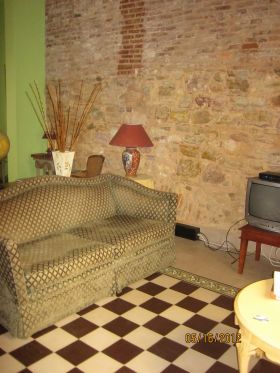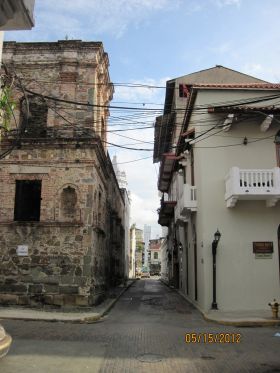What is the history of the Panama City, Panama area of Casco Viejo?
Patrizia Pinzon - Arco Properties
Wao, this is a long one: the history of Casco Antiguo in Panama City, Panama. Here is the short answer: the first city in Panama was "Panama Viejo" which was located in what basically was (and is) a swamp. This city, although it did very well during the Spanish conquest, was not exactly comfortable or easy to defend. Therefore some entrepreneurial pirates found it fun to visit and leave without paying the bill. After being attacked by Henry Morgan and mosquitoes alike, people...
Wao, this is a long one: the history of Casco Antiguo in Panama City, Panama. Here is the short answer: the first city in Panama was "Panama Viejo" which was located in what basically was (and is) a swamp. This city, although it did very well during the Spanish conquest, was not exactly comfortable or easy to defend. Therefore some entrepreneurial pirates found it fun to visit and leave without paying the bill. After being attacked by Henry Morgan and mosquitoes alike, people said "that`s enough"!!! and in a display of common sense just moved out.
The place they chose was a rocky peninsula, with access to fresh water and cross winds. It also had this bizarre 16 ft tide that made it easy to defend and still have access to the water since commerce was what they lived from. That place, which was known at the time as the "Ancon", became "Panama" in 1673. Initially a colonial site, the city grew, flourished and burnt to the ground three times. But each time it came back, which allowed it to introduce architecture from different styles reflecting the types of people who came in waves. As a big salad, Casco became a reflection of the people who lived in it and formed Panama`s mixed DNA. Different waves included the Gold Rush, the French Canal and later the American Canal. In 1903, Casco Viejo saw "Panama" become an independent Republic. As it grew beyond its borders, the city became the "old town" and after going through a period of decay in the 70`s to the 90`s, in 1998 it was declared a World Heritage Site, therefore starting a new era of revitalization, which is what you see today. It is here where you can understand Panama`s roots and cultural heart.
Posted April 25, 2013
Lourdes Townshend
Casco Viejo used to be in the 17th century a "classic neighborhood" for Panamanian residents, after the old Panamá city was burned by pirates.
More recently, the city expanded to other areas like Bella Vista, as the former residents of Casco Viejo left the neighborhood and moved to new ones. After some years, Casco became a neighborhood of low income residents who even couldn´t pay their rents. Even though...
Casco Viejo used to be in the 17th century a "classic neighborhood" for Panamanian residents, after the old Panamá city was burned by pirates.
More recently, the city expanded to other areas like Bella Vista, as the former residents of Casco Viejo left the neighborhood and moved to new ones. After some years, Casco became a neighborhood of low income residents who even couldn´t pay their rents. Even though some important buildings like the Presidential Palace, the National Theater, Central Hotel, Colón Hotel, some historical churches and ruins, the "Bóvedas", French Embassy and the main social club "Club Unión" were in the Casco Viejo, the area in general slowly deteriorated. However, many little business started to bloom as well as a public market and a Chinatown.
At the present time, there is a foundation focused in the restoration of Casco Viejo, and many "cafés", picturesque restaurants and art and craft places have bloomed. The current administration has a special interest in the complete development of the area. By a new law, many buildings have extraordinary new exteriors, all with balconies and beautiful colonial architecture.
But the reality is that Casco Viejo is still surrounded by other neighborhoods that are not as nice, and some low income residents still live in the area. The new "cinta costera" (which is a beautiful boulevard surrounding the city of Panamá) is in full construction, as well as many other mega projects, and will soon be inaugurated, thereby providing an spectacular view of Casco Viejo. Also, they just renovated all the old streets.
Many tour operators offer city tours to this area, as well as the double-decker tourism bus (like the one offered by the city of New York) which costs $39 per person, and allows you to make several stops in tourist sites.
There are also presidential and tourism police everywhere, and locals are very helpful.
You can find all kinds of food from Middle East to Latin, from just a bottle of water to real strong Panamanian coffee. Some prices are touristic.
At night, is advisable to go with a person who knows the area, as you have to pass by some unfamiliar areas. The better ocean view is at day time.
Ahhh, and don´t forget to ask for your "raspao" (kind of frosty, but with a very Panamanian style) at the end, in front of the French Embassy.
Posted November 16, 2013
Rey Bazán
(Casco Viejo and Casco Antiguo are  different names for the same place.)
different names for the same place.)
Casco Antiguo started in 1672, if memory serves me correctly. We still have two buildings dating back to the middle of the 1700s. The reason there aren’t more is that there were a couple of major fires in Casco Antigo, and, originally, most of the buildings were wooden.
Later, you see buildings influenced by the French, with different types of materials, what we call...
 different names for the same place.)
different names for the same place.)Casco Antiguo started in 1672, if memory serves me correctly. We still have two buildings dating back to the middle of the 1700s. The reason there aren’t more is that there were a couple of major fires in Casco Antigo, and, originally, most of the buildings were wooden.
Later, you see buildings influenced by the French, with different types of materials, what we call...
(Casco Viejo and Casco Antiguo are  different names for the same place.)
different names for the same place.)
Casco Antiguo started in 1672, if memory serves me correctly. We still have two buildings dating back to the middle of the 1700s. The reason there aren’t more is that there were a couple of major fires in Casco Antigo, and, originally, most of the buildings were wooden.
Later, you see buildings influenced by the French, with different types of materials, what we call “caletanto”, which is rock and bricks, so that kind of put a new perspective. The French added the grilled balconies, the roofs. Then we had sort of a neo-classic era, with the marble, art deco type buildings, a nice variety.
Casco Viejo was a thriving place up until about the 1930s. Then, many of the economically affluent people who lived in Casco Viejo started to move out towards what could be called the suburbs. As a result, many of the buildings were put up for rent. When the dictatorship came to Panama, in order to help the poor, they froze rents in the early 1970s, which caused the owners to give up on the buildings and not take care of them, so the squatters moved in.
Panama, in order to help the poor, they froze rents in the early 1970s, which caused the owners to give up on the buildings and not take care of them, so the squatters moved in.
Then, in 1996, Panama passed a law to give property tax and other incentives to investors to restore the buildings in Casco Viejo. This started the turnaround, but it’s been a slow process. Not everybody had the vision or the patience to undertake such a task, but as people saw more of the buildings being restored and looking beautiful, that has helped the process, but it’s been a slow process.
In Casco today, you see a mix of extremely beautiful, restored, very nice places, with other places that have yet to be restored. Roughly 20% of Casco Antiguo has been renovated.
 different names for the same place.)
different names for the same place.)Casco Antiguo started in 1672, if memory serves me correctly. We still have two buildings dating back to the middle of the 1700s. The reason there aren’t more is that there were a couple of major fires in Casco Antigo, and, originally, most of the buildings were wooden.
Later, you see buildings influenced by the French, with different types of materials, what we call “caletanto”, which is rock and bricks, so that kind of put a new perspective. The French added the grilled balconies, the roofs. Then we had sort of a neo-classic era, with the marble, art deco type buildings, a nice variety.
Casco Viejo was a thriving place up until about the 1930s. Then, many of the economically affluent people who lived in Casco Viejo started to move out towards what could be called the suburbs. As a result, many of the buildings were put up for rent. When the dictatorship came to
 Panama, in order to help the poor, they froze rents in the early 1970s, which caused the owners to give up on the buildings and not take care of them, so the squatters moved in.
Panama, in order to help the poor, they froze rents in the early 1970s, which caused the owners to give up on the buildings and not take care of them, so the squatters moved in.Then, in 1996, Panama passed a law to give property tax and other incentives to investors to restore the buildings in Casco Viejo. This started the turnaround, but it’s been a slow process. Not everybody had the vision or the patience to undertake such a task, but as people saw more of the buildings being restored and looking beautiful, that has helped the process, but it’s been a slow process.
In Casco today, you see a mix of extremely beautiful, restored, very nice places, with other places that have yet to be restored. Roughly 20% of Casco Antiguo has been renovated.
Posted August 3, 2014


